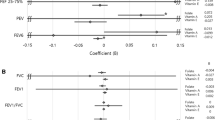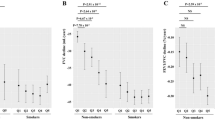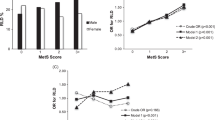Abstract
Background/Objectives
There has been inconsistent relationships between serum vitamin D levels and lung function in previous studies. However, previous studies included patients with medical diseases, affecting both vitamin D levels and lung function. Considering this view of potential confounders, we investigated if vitamin D deficiency (VDD) is linked to lung function in health screening examinee without overt medical conditions.
Subjects/Methods
We conducted a cohort study on 68,457 healthy Koreans (36,759 males, mean age: 37.7 years) with a health examination in 2015. Measured forced expiratory volume in one second (FEV1) and forced vital capacity (FVC) were categorized in quartiles. To examine the relationships between VDD and lung function, adjusted odds ratios (aORs) for VDD were estimated by logistic regression.
Results
Median vitamin D level was 14.9 ng/mL. The prevalence of VDD (defined as <20 ng/ml) was 74.5%. Compared with the highest quartile (Q4, reference), the aORs for VDD across decreasing quartiles (from Q3 to Q1) were 1.05, 1.06, 1.10 for FVC, and 1.07, 1.10, 1.10 for FEV1 (P for trend < 0.01 for both), in all subjects. Similarly, the aOR of having VDD for men also increased with decreasing quartiles of FVC and FEV1 in a dose-response manner (p for trend < 0.01 for both). However, neither FVC nor FEV1 was associated with VDD in women.
Conclusions
VDD was associated with decreased lung function in middle aged Korean men without overt medical conditions. VDD could be a modifiable risk factor for impaired lung function, in men but not in women.
This is a preview of subscription content, access via your institution
Access options
Subscribe to this journal
Receive 12 print issues and online access
$259.00 per year
only $21.58 per issue
Buy this article
- Purchase on Springer Link
- Instant access to full article PDF
Prices may be subject to local taxes which are calculated during checkout


Similar content being viewed by others
References
Parker J, Hashmi O, Dutton D, Mavrodaris A, Stranges S, Kandala NB, et al. Levels of vitamin D and cardiometabolic disorders: systematic review and meta-analysis. Maturitas. 2010;65:225–36.
Holick MF. Vitamin D deficiency. N Engl J Med. 2007;357:266–81.
Herr C, Greulich T, Koczulla RA, Meyer S, Zakharkina T, Branscheidt M, et al. The role of vitamin D in pulmonary disease: COPD, asthma, infection, and cancer. Respir Res. 2011;12:31.
Engstrom G, Hedblad B, Nilsson P, Wollmer P, Berglund G, Janzon L. Lung function, insulin resistance and incidence of cardiovascular disease: a longitudinal cohort study. J Intern Med. 2003;253:574–81.
Janssens W, Bouillon R, Claes B, Carremans C, Lehouck A, Buysschaert I, et al. Vitamin D deficiency is highly prevalent in COPD and correlates with variants in the vitamin D-binding gene. Thorax. 2010;65:215–20.
Persson LJ, Aanerud M, Hiemstra PS, Hardie JA, Bakke PS, Eagan TM. Chronic obstructive pulmonary disease is associated with low levels of vitamin D. PLoS ONE. 2012;7:e38934.
Berry DJ, Hesketh K, Power C, Hypponen E. Vitamin D status has a linear association with seasonal infections and lung function in British adults. Br J Nutr. 2011;106:1433–40.
Black PN, Scragg R. Relationship between serum 25-hydroxyvitamin d and pulmonary function in the third national health and nutrition examination survey. Chest. 2005;128:3792–8.
Thuesen BH, Skaaby T, Husemoen LL, Fenger M, Jorgensen T, Linneberg A. The association of serum 25-OH vitamin D with atopy, asthma, and lung function in a prospective study of Danish adults. Clin Exp Allergy. 2015;45:265–72.
Larose TL, Brumpton BM, Langhammer A, Camargo CA Jr., Chen Y, Romundstad P, et al. Serum 25-hydroxyvitamin D level, smoking and lung function in adults: the HUNT Study. Eur Respir J. 2015;46:355–63.
Choi CJ, Seo M, Choi WS, Kim KS, Youn SA, Lindsey T, et al. Relationship between serum 25-hydroxyvitamin D and lung function among Korean adults in Korea National Health and Nutrition Examination Survey (KNHANES), 2008-2010. J Clin Endocrinol Metab. 2013;98:1703–10.
Kim MS, Choi CJ, Kwon KM, Kim KS, Choi WS, Oh YJ. Association of Lung Function with Serum 25-Hydroxyvitamin D Level according to the Presence of Past Pulmonary Tuberculosis in Korean Adults. Korean J Fam Med 2019;40:93–9.
Park CY, Kwak SY, Jo G, Shin MJ. Genetic association between serum 25-hydroxyvitamin D levels and lung function in Korean men and women: data from KNHANES 2011–2012. Nutrients. 2018;10:1362.
Shim SY, Chae WJ, Kim HC, Park EC, Jang SI. Association between serum 25-hydroxyvitamin D levels and pulmonary function, among Korean adults, during 2010-2014, by sex, age, and body mass index. Respir Med 2018;140:32–8.
Afzal S, Lange P, Bojesen SE, Freiberg JJ, Nordestgaard BG. Plasma 25-hydroxyvitamin D, lung function and risk of chronic obstructive pulmonary disease. Thorax. 2014;69:24–31.
Lange NE, Sparrow D, Vokonas P, Litonjua AA. Vitamin D deficiency, smoking, and lung function in the normative aging study. Am J Respir Crit Care Med 2012;186:616–21.
Kunisaki KM, Niewoehner DE, Singh RJ, Connett JE. Vitamin D status and longitudinal lung function decline in the Lung Health Study. Eur Respir J. 2011;37:238–43.
Niruban SJ, Alagiakrishnan K, Beach J, Senthilselvan A. Association between vitamin D and respiratory outcomes in Canadian adolescents and adults. J Asthma. 2015;52:653–61.
Rafiq R, Thijs W, Prein R, de Jongh RT, Taube C, Hiemstra PS, et al. Associations of serum 25(OH)D concentrations with lung function, airway inflammation and common cold in the general population. Nutrients. 2018;10:35.
Hansen JG, Gao W, Dupuis J, O’Connor GT, Tang W, Kowgier M, et al. Association of 25-Hydroxyvitamin D status and genetic variation in the vitamin D metabolic pathway with FEV1 in the Framingham Heart Study. Respir Res. 2015;16:81.
Shaheen SO, Jameson KA, Robinson SM, Boucher BJ, Syddall HE, Sayer AA, et al. Relationship of vitamin D status to adult lung function and COPD. Thorax. 2011;66:692–8.
Khan S, Mai XM, Chen Y. Plasma 25-hydroxyvitamin D associated with pulmonary function in Canadian adults with excess adiposity. Am J Clin Nutr. 2013;98:174–9.
Wen CP, David Cheng TY, Tsai SP, Chan HT, Hsu HL, Hsu CC, et al. Are Asians at greater mortality risks for being overweight than Caucasians? Redefining obesity for Asians. Public Health Nutr. 2009;12:497–506.
Sung KC, Wild SH, Byrne CD. Development of new fatty liver, or resolution of existing fatty liver, over five years of follow-up, and risk of incident hypertension. J Hepatol. 2014;60:1040–5.
Matthews DR, Hosker JP, Rudenski AS, Naylor BA, Treacher DF, Turner RC. Homeostasis model assessment: insulin resistance and beta-cell function from fasting plasma glucose and insulin concentrations in man. Diabetologia. 1985;28:412–9.
American Thoracic Society. Standardization of spirometry, 1994 update. Am J Respir Crit Care Med. 1995;152:1107–36.
Choi HS, Oh HJ, Choi H, Choi WH, Kim JG, Kim KM, et al. Vitamin D insufficiency in Korea-a greater threat to younger generation: the Korea National Health and Nutrition Examination Survey (KNHANES) 2008. J Clin Endocrinol Metab. 2011;96:643–51.
Cirillo DJ, Agrawal Y, Cassano PA. Lipids and pulmonary function in the Third National Health and Nutrition Examination Survey. Am J Epidemiol. 2002;155:842–8.
Vitezova A, Voortman T, Zillikens MC, Jansen PW, Hofman A, Uitterlinden AG, et al. Bidirectional associations between circulating vitamin D and cholesterol levels: the Rotterdam Study. Maturitas. 2015;82:411–7.
Hurskainen AR, Virtanen JK, Tuomainen TP, Nurmi T, Voutilainen S. Association of serum 25-hydroxyvitamin D with type 2 diabetes and markers of insulin resistance in a general older population in Finland. Diabetes Metab Res Rev. 2012;28:418–23.
Cannell JJ, Grant WB, Holick MF. Vitamin D and inflammation. Dermatoendocrinol. 2014;6:e983401.
Shaaban R, Kony S, Driss F, Leynaert B, Soussan D, Pin I, et al. Change in C-reactive protein levels and FEV1 decline: a longitudinal population-based study. Respir Med. 2006;100:2112–20.
Brot C, Jorgensen NR, Sorensen OH. The influence of smoking on vitamin D status and calcium metabolism. Eur J Clin Nutr. 1999;53:920–6.
Thuesen BH, Heede NG, Tang L, Skaaby T, Thyssen JP, Friedrich N, et al. No association between vitamin D and atopy, asthma, lung function or atopic dermatitis: a prospective study in adults. Allergy. 2015;70:1501–4.
Xu J, Bartz TM, Chittoor G, Eiriksdottir G, Manichaikul AW, Sun F, et al. Meta-analysis across Cohorts for Heart and Aging Research in Genomic Epidemiology (CHARGE) consortium provides evidence for an association of serum vitamin D with pulmonary function. Br J Nutr. 2018;120:1159–70.
Sluyter JD, Camargo CA, Waayer D, Lawes CMM, Toop L, Khaw KT, et al. Effect of monthly, high-dose, long-term Vitamin D on lung function: a randomized controlled trial. Nutrients. 2017;9:1353.
Gibson JB, Martin NG, Oakeshott JG, Rowell DM, Clark P. Lung function in an Australian population: contributions of polygenic factors and the Pi locus to individual differences in lung function in a sample of twins. Ann Hum Biol. 1983;10:547–56.
Protiva P, Cross HS, Hopkins ME, Kallay E, Bises G, Dreyhaupt E, et al. Chemoprevention of colorectal neoplasia by estrogen: potential role of vitamin D activity. Cancer Prev Res (Philos) 2009;2:43–51.
Mithal A, Wahl DA, Bonjour JP, Burckhardt P, Dawson-Hughes B, Eisman JA, et al. Global vitamin D status and determinants of hypovitaminosis D. Osteoporos Int. 2009;20:1807–20.
Berraies A, Hamzaoui K, Hamzaoui A. Link between vitamin D and airway remodeling. J Asthma Allergy. 2014;7:23–30.
van Eeden SF, Tan WC, Suwa T, Mukae H, Terashima T, Fujii T, et al. Cytokines involved in the systemic inflammatory response induced by exposure to particulate matter air pollutants (PM(10)). Am J Respir Crit Care Med. 2001;164:826–30.
American Thoracic Society. Chronic obstructive pulmonary disease: a disorder of the cardiovascular and respiratory systems. Lund, Sweden, April 15-16, 2004. Proceedings. Proc Am Thorac Soc. 2005;2:5–100.
Hole DJ, Watt GC, Davey-Smith G, Hart CL, Gillis CR, Hawthorne VM. Impaired lung function and mortality risk in men and women: findings from the Renfrew and Paisley prospective population study. BMJ. 1996;313:711–5. discussion 5–6.
Scientific Advisory Committee on Nutrition. Update on vitamin D: position statement by the Scientific Advisory Committee on Nutrition. (The Stationery Office, Norwich, 2007).
Sonderman JS, Munro HM, Blot WJ, Signorello LB. Reproducibility of serum 25-hydroxyvitamin d and vitamin D-binding protein levels over time in a prospective cohort study of black and white adults. Am J Epidemiol. 2012;176:615–21.
Funding
This work was supported by a research grant from Jeju National University Hospital development fund in 2019.
Author information
Authors and Affiliations
Contributions
Conception and design: J-U.S Data analysis, interpretation, and manuscript writing: J-US; JL; HKP. Revision of the manuscript and contribution of intellectual content: J-US; JL; HKP; M-JK; S-YH and SYL.
Corresponding author
Ethics declarations
Conflict of interest
The authors declare that they have no conflict of interest.
Additional information
Publisher’s note Springer Nature remains neutral with regard to jurisdictional claims in published maps and institutional affiliations.
Supplementary information
Rights and permissions
About this article
Cite this article
Lee, J., Park, H.K., Kwon, MJ. et al. Decreased lung function is associated with vitamin D deficiency in apparently health, middle aged Koreans: the Kangbuk Samsung Health Study. Eur J Clin Nutr 75, 501–512 (2021). https://doi.org/10.1038/s41430-020-00748-7
Received:
Revised:
Accepted:
Published:
Issue Date:
DOI: https://doi.org/10.1038/s41430-020-00748-7



